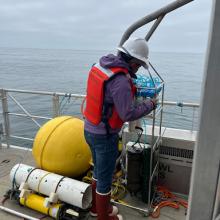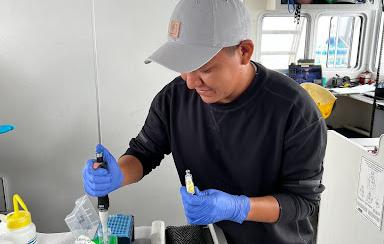Hello, my name is Owen Yazzie, and I am a Cooperative Institute for Climate, Ocean, and Ecosystem Studies (CICOES) undergraduate research intern working at the University of Washington. This summer, I assisted the ‘Omics Group with an ongoing project in the Olympic Coast National Marine Sanctuary (OCNMS), off the outer coast of Washington state. The Ocean Molecular Ecology group is working with OCNMS to deploy autonomous environmental (e)DNA samplers in the sanctuary to study how biodiversity changes during and surrounding hypoxic events. During the 2022 field season, the group has two planned deployments scheduled, with automated samplers out for a month-long window at two sites (Teahwhit Head and Cape Elizabeth). These automated samplers collect a total of 24 samples spaced every 36 hours, eliminating the need for costly in-person sampling. I participated in the summer recovery cruise at OCNMS, and that opportunity allowed me to gain hands-on experience in the lab and in the field. Aside from the lab/research experience, there were other first time experiences for myself, such as seeing marine life outside of an enclosure.

In preparation for fieldwork, I assisted with packing gear and sterilizing equipment required for eDNA sampling. Environmental DNA samples are prone to contamination, so it was important we carefully sterilize the bottles and tubing used in the field. On the two-day recovery cruise, aboard the OCNMS vessel, the R/V Storm Petrel, we recovered both automated samplers and collected water samples using a CTD niskin array at Teahwhit Head and Cape Elizabeth. To generate occupancy models, which account for imperfect detection of organisms and to determine the probability of their true presence or absence, we collected 10 water samples near the automated sampler just prior to recovery to supplement a sliding window analysis. To do this, we started by lowering a CTD niskin array to the depth of the sampler, niskin bottles were then closed to capture water at that depth, and once returned to the ship deck, we collected the water samples in our sterilized bottles. Later we filtered the eDNA from those samples, while maintaining sterile technique to prevent contamination. I assisted with multiple steps of the filtration process, including the preservation of the eDNA samples in ethanol. I also worked alongside the OCNMS crew to recover the automated samplers. These moorings included an acoustic release mechanism, which allowed for the recovery of the entire mooring and ensured we did not leave anything behind. On both days, I helped collect the 24 samples (i.e., filters) from the automated samplers, while maintaining sterility during this process. Assisting with this project was a very rewarding experience that I am grateful to have taken part in.



